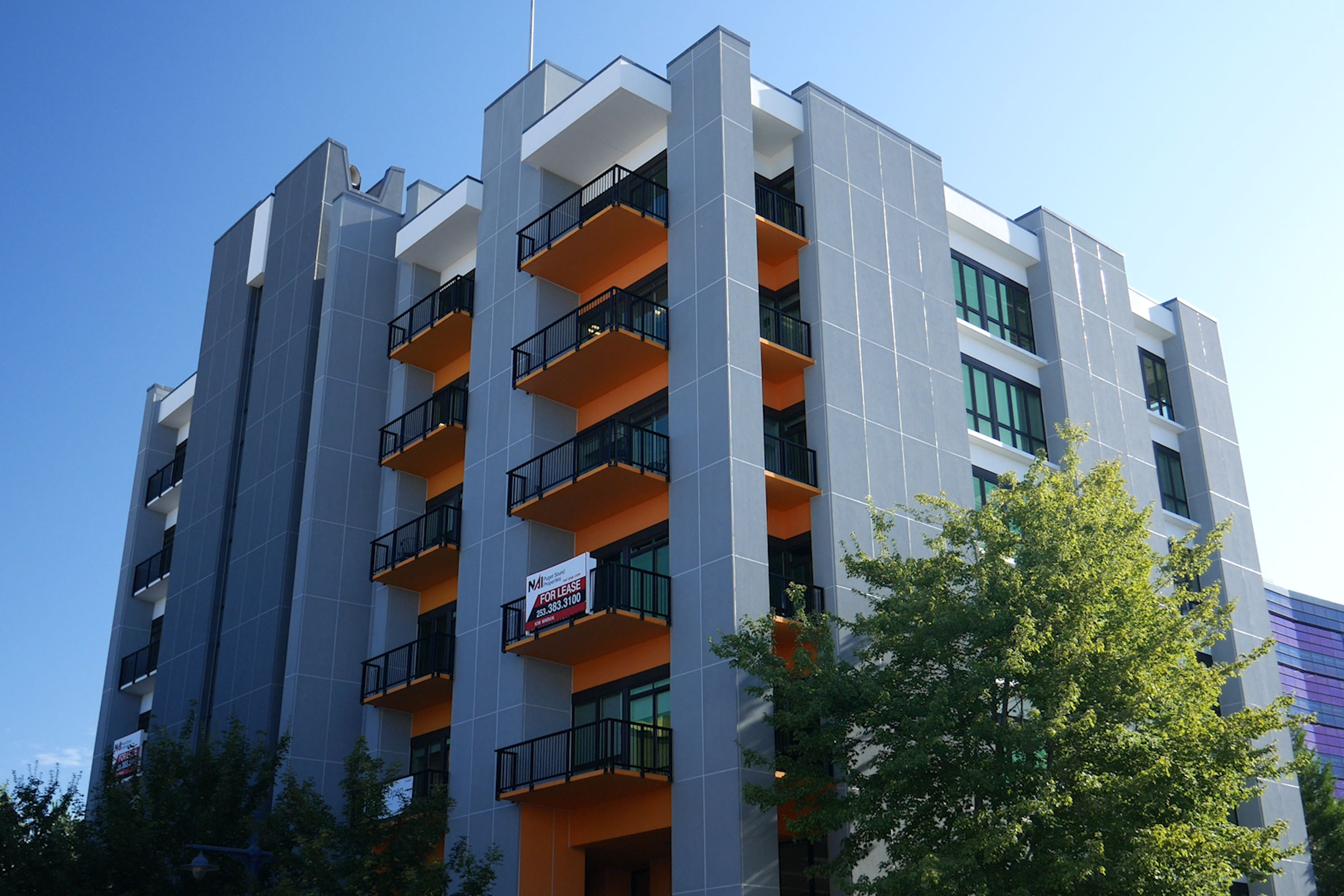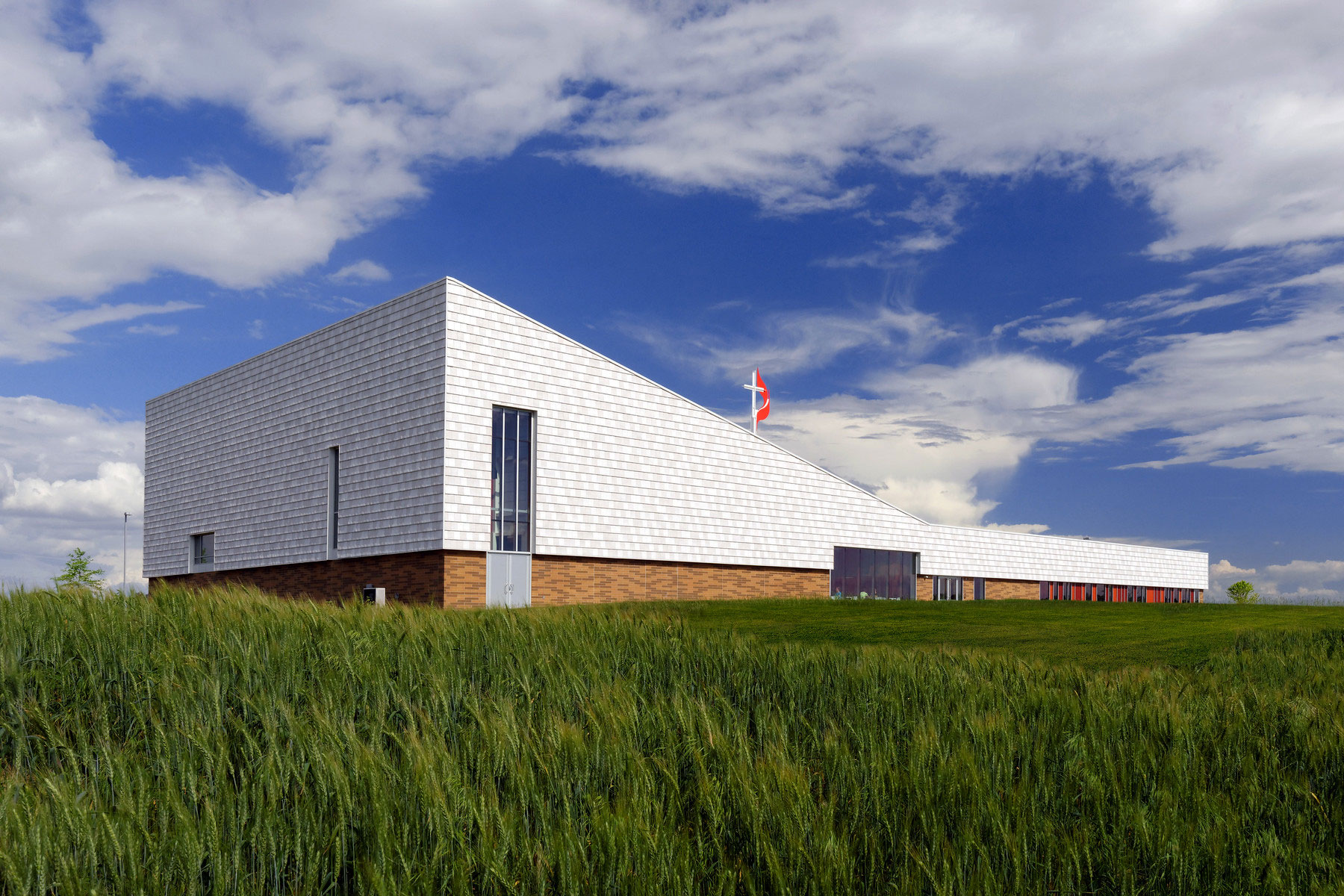Story at a glance:
- A 673,000-square-foot addition to the existing Milwaukee convention center results in the 1,300,000-square-foot Baird Center.
- The expanded project is Milwaukee-centric in design and construction.
- The owner was committed to diversity, equity, and inclusion goals during the project.
As the world was awakening from the Covid pandemic in 2021, the owner of Milwaukee’s convention center, then known as the Wisconsin Center, was moving forward on plans to expand the facility.
From the time it was built in 1998, the 600,000-square-foot venue was not large enough to attract national conventions and events or hold several conferences simultaneously. Marty Brooks, president and CEO of the Wisconsin Center District, owners and operators of Baird Center, and his colleagues wanted an addition that would make the convention center the crown jewel of Milwaukee, which in recent years has gained national attention for its arts, food, and sports scenes. With a population of approximately 556,000 people, Milwaukee is a little big city.
“It was interesting to hear how the owner planned to market the expanded convention center,” says John Gilroy, project executive onsite with Gilbane Building Company, construction manager on the Baird Center project. “They must communicate all the unique aspects of the convention center because it is competing against Nashville, Las Vegas, and Chicago for events. One thing the building must do is overcome this perception that you’re coming to Milwaukee, and only then can the owner talk about this cool city.”
The now 1,300,000-square-foot Baird Center provides all the amenities large conventions require: It boasts 300,000 square feet of contiguous exhibit hall space, 52 flexible meeting rooms (24 new) with robust IT infrastructure, back-of-house services, six new loading docks (for a total of 22), and executive kitchen facilities with a private tasting room. The Baird Center also dramatically separates itself from other venues with a Milwaukee-centric design, providing travelers with a uniquely local experience, as well as the 32,000-square-foot rooftop Baird Ballroom with the adjacent Baird Sky View Terrace for more impactful events.
The design and construction team exceeded the project’s sustainability goals; the building currently is pursuing LEED Gold from an initial Silver target. Among its most outstanding contribution to sustainability was the project’s dedication to people.
Built for Milwaukee, By Milwaukee
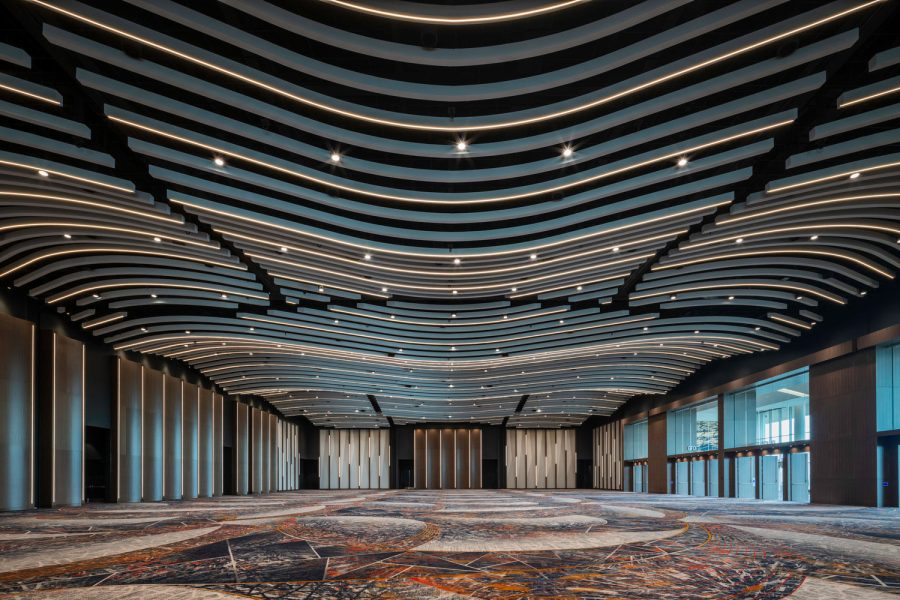
Lighting controls from ETC ensure the Baird Center’s LED lighting adjusts for occupancy and daylight. Photo by C+N Photography
TVS, the Baird Center’s design architect, was also the architect of record on the existing Wisconsin Center, which hadn’t aged well, according to Rob O’Keefe, design principal. “The aesthetic of the time was different, and the mayor back then had a strong opinion about what the convention center should look like,” O’Keefe says. The existing building features a pinkish brick, green glass, and ornate decorations.
Brooks was clear he didn’t want the expansion to mimic the existing design so he gave TVS and its local architectural partner EUA creative latitude. “We didn’t have the financial capacity to make major changes to the existing building so we made the new and existing complement each other,” O’Keefe says. “We picked similar glass variations, pulling hues that complement but don’t replicate, for example.”
Brooks stressed that the Baird Center would be a building “built for Milwaukee by Milwaukee.” With that in mind the design team created a concept for the addition unique to the city. “You can’t just pick up this building and place it in another city and have it hold merit,” O’Keefe says.
Milwaukee’s blue-collar history is alluded to with the addition’s industrial materials. For example, the structural frame is exposed in the exhibit hall, and the dark-gray metal cladding refers to the city’s manufacturing past.
Sharp vertical and horizontal forms colliding on the building enclosure represent ice breaking against the shoreline of Lake Michigan. “It’s not obvious, but if you study the building you start to see those sharp geometric shapes merging with each other,” O’Keefe says.
In addition, the We Energies Foundation Art Collection, which features mainly local artists who showcase Milwaukee and Wisconsin’s people and landscapes, can be found throughout the new and existing spaces.
North Meets South
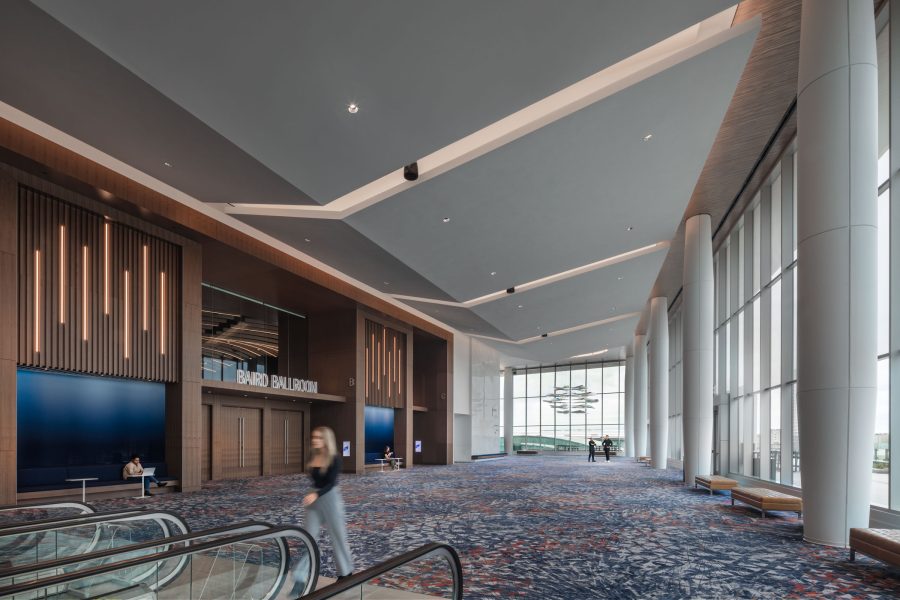
Custom carpet from Brintons was installed throughout to tie the Baird Center addition into the existing building. Photo by C+N Photography
The addition’s programming requirements were vast, resulting in a vertical expansion because of limited space in Milwaukee’s dense downtown. To achieve the desired 300,000 contiguous square feet of exhibit space, the design pushes the building over the property line. New meeting rooms were tucked underneath an existing appendage on the building’s east side. The new Baird Ballroom adds elegance to the roof—though set back from the edge of the addition to respect the existing building’s massing—and leftover space became back-of-house and concourses, stitching all the programmatic requirements together. “It was tight,” O’Keefe says. “Squeezing everything into a small footprint was the biggest challenge and the most fun. It truly was a nesting of the two projects.”
Gilroy says a significant amount of foundation reinforcement was necessary on one of the existing column lines transitioning from new to old. Seismic updates also were required on the existing building to meet current code.
Inside the entire facility appears new. In fact, the Baird Center team refers to the existing and new portions as South and North, respectively. (Not many convention owners will choose to be placed in the “old” portion of a building.) Custom carpet was installed throughout. South restrooms were refreshed, and existing meeting rooms were modernized.
A Drive for Sustainability
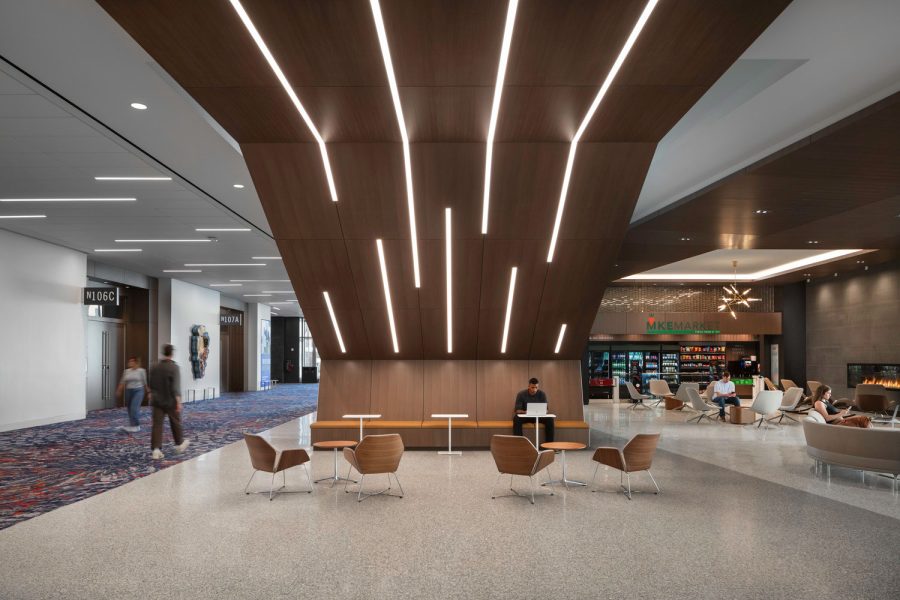
LED lighting, colorful carpet, and warm interiors dominate the Baird Center expansion. Photo by C+N Photography
The design and construction team diligently worked to be sustainable in all aspects of the construction process.
Materials were sourced as close to the building site as possible. The addition’s 30-foot-tall steel members were transported from the Madison area, 90 miles west of Milwaukee. During construction the team also diverted 83% of construction waste from landfills—a total of 9,790 tons of waste.
Other sustainability aspects include the following:
• Rooftop solar produces 98,000 kilowatts of energy.
• Low-flow plumbing fixtures from Bradley save 700,000 gallons of water per year.
• Underground cisterns can capture 320,000 gallons of stormwater.
• A food digester turns 438 tons of annual food waste into liquid, diverting it from landfills.
• Low-E, fritted glass saves energy while protecting birds from collisions.
• LED lighting with sensors adjusts to room occupancy and daylight.
Local Love

Inside the Baird Center expansion project in Milwaukee. Photo by C+N Photography
As part of his “built for Milwaukee by Milwaukee” mantra, Brooks was committed to local labor. “Of the roughly 80 subcontracts that were issued, all but two were from Wisconsin firms,” Gilroy says.
Diversity, equity, and inclusion were top of mind. The Baird Center project received labor and services from 25.3% minority-owned businesses, 16.5% women-owned businesses, and 1% disabled-veteran-owned businesses, exceeding its goal of utilizing 31% minority groups.
In addition, Baird Center participated in Milwaukee’s Residents Preference Program, or RPP, which helps individuals who have been unemployed or under-employed find steady work. Any projects financed with public tax dollars are required by the City of Milwaukee to hire a percentage of RPP-certified Milwaukee residents. The Baird Center boasts 41.3% RPP workforce, which greatly exceeded requirements.
“For many of these workers it may be their first time in the trades,” says Alicia Dupies, Gilbane’s project principal on the Baird Center. “A local workforce organization—WRTP | Big Step—certifies workers as RPP and Gilbane’s economic inclusion specialist ensures we achieve the required participation.”
Before Baird Center officially opened, Brooks and his team thanked the project’s workforce by hosting an open house where workers could showcase their craftsmanship to their families. “To hear people speaking in different languages to their kids about how they participated in this building was so cool,” Dupies says. “I haven’t ever been part of a project where the commitment ‘built for Milwaukee by Milwaukee’ went so deep.”
Brooks’ commitment to the building’s workforce at all levels was appreciated by the design and construction team. “Marty was such a joy to work with,” O’Keefe says. “He gave us the opportunity to create a convention center project that really transforms the community. The impact this project has had on Milwaukee and how it has been received nationally is so rewarding.”
“There was an incredibly strong alignment between the owner, owner’s reps, all our trade partners, and all the individuals onsite,” Gilroy says. “It never felt like anyone was rowing in the wrong direction. Everybody was invested in rowing together to the end successfully.
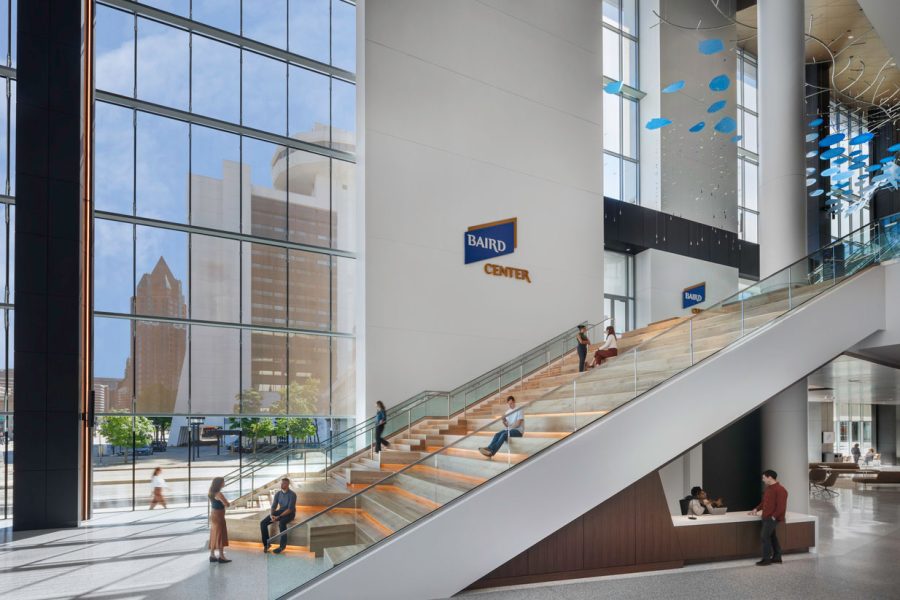
Wood from the Urban Wood Network’s Wisconsin State Chapter forms the collaborative stair. Members of the Urban Wood Network reclaim local trees that have reached the end of their lives and transform them into various wood goods. Photo by C+N Photography

The Baird Center expansion in Milwaukee was completed in March 2024. Photo by C+N Photography
Project Details
Project: Baird Center
Location: Milwaukee
Completion: March 2024
Size: 673,000 square feet
Cost: $456 million
Design Architect and Co-Interior Designer: TVS
Architect of Record, Co-Interior Designer & Construction Administrator: EUA
Construction Management Partners: Gilbane Building Company & C.D. Smith Construction



